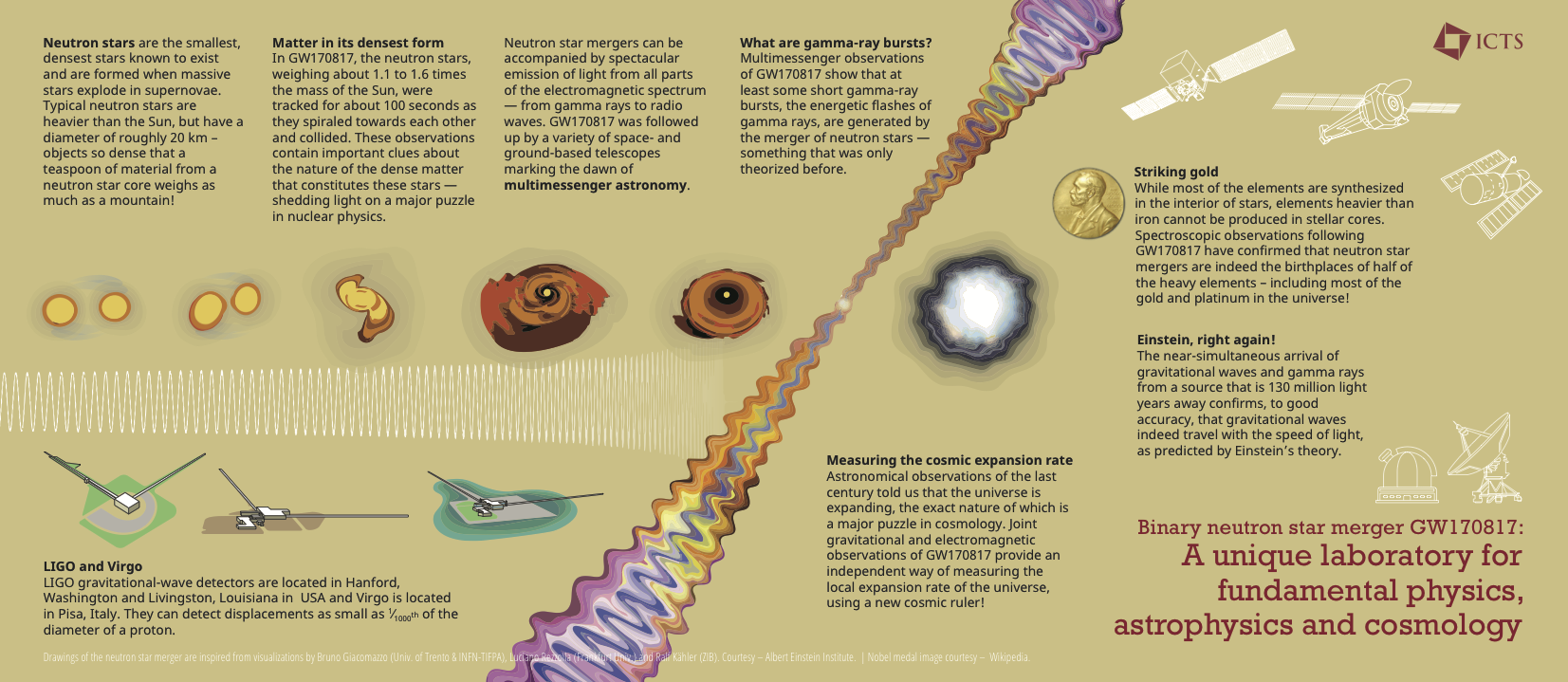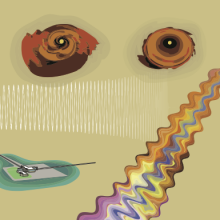The beginning of gravitational-wave multimessenger astronomy
17 August 2017 saw a major breakthrough in astronomy, when gravitational waves from a pair of colliding neutron stars were detected for the first time by the US-based Laser Interferometer Gravitational-Wave Observatory (LIGO) and the Europe-based Virgo. This happens to be the strongest gravitational-wave signal detected so far, owing to the relatively close location of about 130 million light-years from earth. The detection was also confirmed by a large number of telescopes around the world that studied various forms of radiation from the merger. This is a new milestone in the success saga of advanced gravitational wave detectors, which have announced the discoveries of four black hole mergers to date. The first such detection in 2015 led to the awarding of the Nobel prize in physics this year.
Neutron stars are the smallest, densest stars known to exist and are formed when massive stars explode in supernovas. Typical neutron stars are heavier than the sun, but have a diameter of just about 20 kilometers: objects so dense that a teaspoon of neutron star material weighs more than Mount Everest. Scientists could track these neutron stars, weighing about 1.1 to 1.6 times the mass of the sun, for about 100 seconds as they spiraled towards each other in a final deadly dance and collided. These observations contain important clues about the nature of the dense matter that constitute these stars.

Let there be light
The collision created a flash of gamma rays that was detected by earth-orbiting satellites just two seconds after the gravitational waves. This is the first conclusive evidence that short gamma ray bursts, often seen by orbiting satellites, are indeed created by colliding neutron stars — something that had only been speculated for decades. The near simultaneous arrival of gravitational waves and gamma rays from a source that is 130 million light years away confirms that gravitational waves indeed travel with the speed of light, as predicted by Einstein’s theory. These joint observations also provided scientists an independent way of measuring the expansion rate of the universe.
Striking gold
In the days that followed, astronomers pinpointed the source on the sky and studied it extensively in various forms of electromagnetic radiation, including X-ray, ultraviolet, optical, infrared, and radio waves. These joint observations clearly show that at least some short gamma-ray bursts, the energetic flashes of gamma rays, are generated by the merging of neutron stars — something that was only theorized before. These studies showed signatures of newly synthesized elements, confirming that such mergers are indeed the birthplaces of half of the elements heavier than iron – including most of the gold and platinum in the universe.
Indian contributions
Indian scientists have made pioneering contributions to the gravitational-wave science over the last three decades. 40 scientists from 13 Indian institutions are part of the LIGO-Virgo discovery paper. Indian scientists contributed to the fundamental algorithms crucial to search for inspiraling binaries in noisy data from multiple detectors, in computing waveforms for these signals by solving Einstein’s equations, in separating astrophysical signals from numerous instrumental and environmental artefacts, in interpretation of joint gravitational-wave and gamma-ray observations, tests of Einstein’s theory and many other aspects of the data analysis. In addition, several Indian telescopes such as AstroSat, Giant Metrewave Radio Telescope (GMRT) and the Himalayan Chandra Telescope (HCT) participated in the search for electromagnetic flashes. The sensitive CZTI instrument on AstroSat helped narrow down the location of the gamma-ray flashes. HCT obtained optical images at locations of neutrinos detected by other telescopes at the same time as the burst, and showed that they were unrelated to the gravitational-wave trigger. GMRT played a key role in understanding jet physics and refining models of radio emission from the remnant formed by the merging neutron stars.
The Indian team in LIGO includes scientists from CMI Chennai, ICTS-TIFR Bangalore, IISER Kolkata, IISER Trivandrum, IIT Bombay, IIT Gandhinagar, IIT Hyderabad, IIT Madras, IPR Gandhinagar, IUCAA Pune, RRCAT Indore, TIFR Mumbai and UAIR Gandhinagar. Astronomers from IISER Pune, IIT Bombay, IUCAA Pune, TIFR Mumbai, PRL Ahmedabad, IIT Hyderabad, IIA Bangalore, NCRA-TIFR Pune, ARIES Nainital and IIST Trivandrum participated in the electromagnetic follow-up of this event using a variety of telescopes.
The planned LIGO-India detector, to be funded by Department of Atomic Energy (DAE) and the Department of Science & Technology (DST), will increase the sensitivity of the international gravitational-wave network and produce many fold improvement to the localisation of the sources. Astronomers will then be able to identify the exact location of the cosmic explosion a lot quicker, and study right from the first moments in every frequency band of the electromagnetic spectrum.
The LIGO-Virgo results are published today in the journal Physical Review Letters; additional papers from the LIGO and Virgo collaborations and the astronomical community have been either submitted or accepted for publication in various journals. A partial list of publications with Indian contributions is available here
LIGO is funded by the NSF, and operated by Caltech and MIT, which conceived of LIGO and led the Initial and Advanced LIGO projects. Financial support for the Advanced LIGO project was led by the NSF with Germany (Max Planck Society), the U.K. (Science and Technology Facilities Council) and Australia (Australian Research Council) making significant commitments and contributions to the project. More than 1,200 scientists and some 100 institutions from around the world participate in the effort through the LIGO Scientific Collaboration, which includes the GEO Collaboration and the Australian collaboration OzGrav. Additional partners are listed at http://ligo.org/partners.php
The Virgo collaboration consists of more than 280 physicists and engineers belonging to 20 different European research groups: six from Centre National de la Recherche Scientifique (CNRS) in France; eight from the Istituto Nazionale di Fisica Nucleare (INFN) in Italy; two in the Netherlands with Nikhef; the MTA Wigner RCP in Hungary; the POLGRAW group in Poland; Spain with the University of Valencia; and the European Gravitational Observatory, EGO, the laboratory hosting the Virgo detector near Pisa in Italy, funded by CNRS, INFN, and Nikhef.


